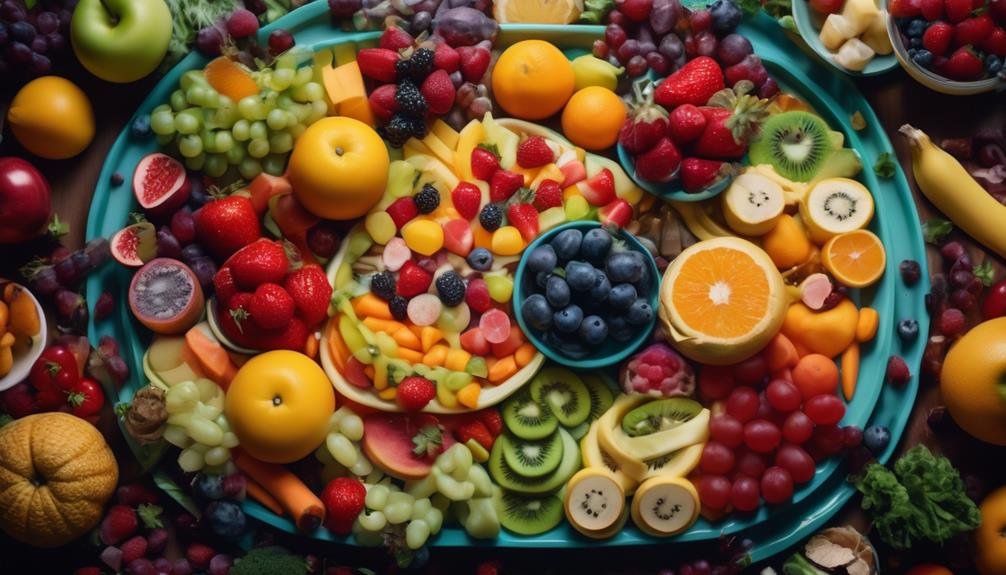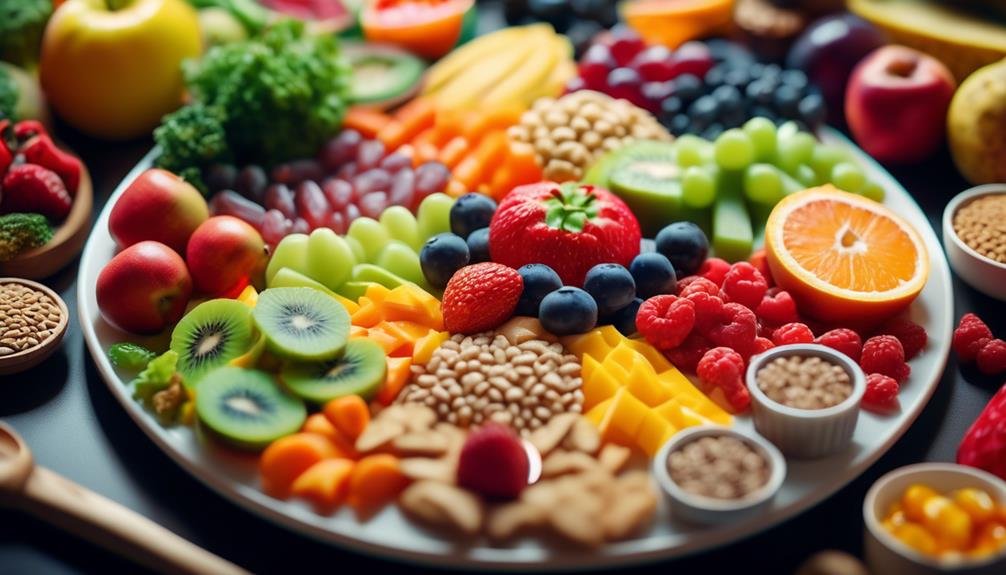"Cherishing Little Steps - A Haven for Baby and Family Journeys"
3-Year-Old Diet Diversity
Have you ever wondered if the saying 'you are what you eat' applies to your 3-year-old? Well, it turns out that the diversity of your child's diet plays a significant role in their overall health and development.
But how exactly does a varied diet benefit your little one? And what can you do to ensure they are getting the nutrients they need?
In this discussion, we will explore the importance of diet diversity for 3-year-olds and provide valuable tips on how to introduce new foods and create a healthy eating environment that your child will love.
So, let's dive in and discover the secrets to nourishing your child's growing body and mind.
Key Takeaways
- A varied diet supports overall health and development in 3-year-olds.
- Exposure to different foods and repeated exposure increase liking for certain foods.
- Parental eating habits and modeling behavior influence a 3-year-old's food preferences.
- Creative ways to make healthy eating fun for toddlers can help expand their palate and encourage them to try new foods.
Understanding the Importance of Diet Diversity

Understanding the importance of diet diversity is crucial for ensuring optimal nutrition and development in young children. The impact of diet diversity on long-term health can't be overstated. Research has shown that a varied diet rich in fruits, vegetables, whole grains, lean proteins, and healthy fats can have a positive effect on a child's overall health and well-being.
One key aspect of diet diversity is its relationship to immune system function. A diverse diet helps to strengthen the immune system, making it better equipped to fight off infections and illnesses. By exposing children to a wide range of nutrients, vitamins, and minerals, their immune systems become more robust and resilient.
Furthermore, a diverse diet can also help prevent the development of chronic diseases later in life. Studies have shown that individuals who consume a varied diet are less likely to develop conditions such as obesity, diabetes, and heart disease. The nutrients found in different foods work together synergistically to support overall health and reduce the risk of these diseases.
Factors Influencing a 3-Year-Old's Food Preferences
To help your 3-year-old develop healthy food preferences, it's important to consider the factors that influence their choices. Several factors can impact a child's food preferences, including their exposure to different foods, their innate taste preferences, and the influence of their parents' eating habits.
Research has shown that children's food preferences are strongly influenced by their exposure to various foods. Introducing a wide variety of foods early on can help expand their palate and increase their acceptance of new flavors. Additionally, repeated exposure to certain foods can also increase their liking for those foods over time.
Another key factor in shaping a child's food preferences is their innate taste preferences. Some children may naturally prefer sweeter foods, while others may prefer more savory or bitter flavors. Understanding your child's individual taste preferences can help you offer them a range of foods that they are more likely to enjoy.
Furthermore, the impact of parental eating habits cannot be underestimated. Children tend to model their behavior after their parents, so if you consistently make healthy food choices, your child is more likely to do the same. On the other hand, if you have poor eating habits, your child may develop similar preferences.
By considering these factors and providing a variety of nutritious foods, you can help your 3-year-old develop healthy food preferences that will set them on a path to lifelong well-being.
| Factors Influencing Food Preferences | Impact of Parental Eating Habits |
|---|---|
| Exposure to different foods | Modeling behavior |
| Innate taste preferences | Consistency in making healthy choices |
Tips for Introducing New Foods to Your 3-Year-Old

When introducing new foods to your 3-year-old, it can be helpful to start with small portions and gradually increase the variety and quantity. This approach allows your child to become familiar with different flavors and textures without overwhelming them. Picky eaters may need more time to adjust to new foods, so it's important to be patient and persistent.
One effective strategy is to offer a new food alongside familiar foods that your child already enjoys. This can help create a positive association with the new food and increase the likelihood of them trying it. Additionally, involving your child in the food preparation process can make them more excited to try new things. You can ask them to help wash the vegetables or stir the soup, making it a fun and interactive experience.
Another tip is to make the new food visually appealing. Children are more likely to try something if it looks interesting and appetizing. You can cut fruits and vegetables into fun shapes, or arrange them in a colorful and appealing way on their plate.
Remember to offer new foods multiple times, as research shows that it can take several attempts before a child accepts a new food. Don't force your child to eat or finish everything on their plate, as this can create negative associations with food. Instead, encourage them to try a small bite and praise their efforts.
Creative Ways to Make Healthy Eating Fun for Toddlers
To make healthy eating more enjoyable for toddlers, try incorporating creative and engaging activities that encourage them to explore and try new foods. Interactive meals and playful presentations can make mealtime a fun and interactive experience for your little one.
One idea is to create a build-your-own meal station. Set out a variety of healthy ingredients, such as chopped fruits, veggies, and proteins, and let your toddler assemble their own meal. This not only gives them a sense of control and independence, but also encourages them to try new foods.
Another fun activity is to make food art. Use cookie cutters to create fun shapes out of fruits, vegetables, and whole grain bread. Let your toddler help arrange the shapes on their plate to create a colorful and visually appealing meal. This can make eating healthy foods more exciting and enticing for them.
You can also turn mealtime into a learning experience by playing food-themed games. For example, you can play 'Guess the Vegetable' by blindfolding your toddler and having them taste different vegetables to guess what they are. This can help expand their palate and make trying new foods a fun challenge.
Balancing Nutritional Needs for Optimal Growth

Balancing your child's nutritional needs is crucial for their optimal growth and development. As a parent, it's important to promote healthy eating habits and provide your toddler with the right nutrients they need to thrive.
Here are three nutritional guidelines to consider:
- Offer a variety of foods: Introduce your child to a wide range of fruits, vegetables, whole grains, lean proteins, and dairy products. This helps ensure they receive a balanced mix of vitamins, minerals, and other essential nutrients. Encourage them to try new foods and flavors, making mealtime an opportunity for exploration and discovery.
- Limit added sugars and salt: Excessive consumption of sugary snacks and drinks can lead to health problems like obesity and tooth decay. Similarly, too much salt can negatively impact your child's blood pressure and kidney function. Be mindful of the amount of sugar and salt in your toddler's diet and opt for healthier alternatives whenever possible.
- Monitor portion sizes: Toddlers have small stomachs, so it's important to offer appropriate portion sizes. Serve meals and snacks that are age-appropriate and listen to your child's hunger and fullness cues. Avoid forcing them to finish everything on their plate and encourage them to eat until they're satisfied.
Overcoming Challenges and Dealing With Picky Eating Habits
Overcoming challenges and dealing with picky eating habits can be a frustrating task for parents, but it's important to approach the situation with patience and understanding. Picky eaters can turn mealtime into battles, making it difficult for parents to ensure their child receives proper nutrition.
However, it's crucial to remember that picky eating is a common phase that many children go through.
To address picky eating habits, it's essential to create a positive and relaxed mealtime environment. Avoid pressuring your child to eat or making mealtimes stressful. Instead, offer a variety of nutritious foods and allow your child to choose what they want to eat from the options provided. Encourage them to try new foods but avoid forcing them.
It's also helpful to involve your child in meal planning and preparation. Take them grocery shopping and let them pick out fruits and vegetables they find interesting. Allow them to participate in simple cooking tasks, such as washing vegetables or stirring ingredients. By involving them in the process, they may be more inclined to try new foods.
Another strategy is to be a role model. Children often mimic the behavior of their parents, so make sure you're demonstrating healthy eating habits yourself. Show enthusiasm for trying new foods and be positive about the foods you enjoy.
Frequently Asked Questions
What Are the Long-Term Effects of a Limited Diet on a 3-Year-Old's Health?
Long-term consequences of limited diets in 3-year-olds can negatively impact their health. Dietary restrictions may lead to nutrient deficiencies, growth and developmental issues, and increased risk of chronic diseases.
How Can Parents Encourage Their 3-Year-Old to Try New Foods Without Resorting to Bribes or Rewards?
To encourage your 3-year-old to try new foods without bribes or rewards, involve them in meal planning, let them explore different textures and flavors, and be a positive role model by enjoying a balanced diet yourself.
Are There Any Specific Nutrients That Are Particularly Important for a 3-Year-Old's Growth and Development?
You might be wondering about the specific nutrients that are crucial for your 3-year-old's growth and development. Well, there are a few key ones, such as iron, calcium, and omega-3 fatty acids. These nutrients play a vital role in supporting your child's overall health and well-being.
How Can Parents Deal With the Frustration of a Picky Eater While Still Ensuring Their Child Receives Proper Nutrition?
As a parent, it's frustrating when your child is a picky eater. However, you can ensure their nutrition by offering balanced meals with a variety of foods. Stay patient and introduce new foods gradually.
Is There a Correlation Between a 3-Year-Old's Diet Diversity and Their Cognitive Development?
Having a diverse diet at 3 years old has a correlation with language development and social skills. Studies show that children who eat a variety of foods have better cognitive outcomes.
Conclusion
In conclusion, fostering diet diversity in a 3-year-old is crucial for their optimal growth and development.
By introducing new foods and making healthy eating fun, you can overcome challenges and picky eating habits.
Remember, variety is the spice of life, and just like a garden blossoms with different flowers, your child's diet should bloom with a colorful array of nutritious choices.
So, let's sprinkle their meals with love and watch them thrive!

